|
Boomerangs and kites are rare sights these days.
Both devices require a fair amount of real estate to use, and even in the suburbs, that kind of space
is getting harder and harder to find. It is amazing to watch television shows and movies from the black
and white era and notice how relatively unpopulated cities and towns were compared to today. While watching
an early episode of
The Beverly Hillbillies the other day, I was struck by how open the Pacific
coastline was in the
 early 1960s, and how nowadays it seems
every foot of it is occupied by a house. Even the foothills a ways back from the coast were barren.
Nevertheless, it is still possible to buy really nice kites and boomerangs. Many have been computer
optimized for ultimate performance. This article offers some tips for flying a boomerang. early 1960s, and how nowadays it seems
every foot of it is occupied by a house. Even the foothills a ways back from the coast were barren.
Nevertheless, it is still possible to buy really nice kites and boomerangs. Many have been computer
optimized for ultimate performance. This article offers some tips for flying a boomerang.
Aerial Horse-Shoe Game: New Fun with Oldest "Whirlybird" - The Boomerang.
A Study in Aerodynamics - Technique wins!
By Lawrence H. Conover
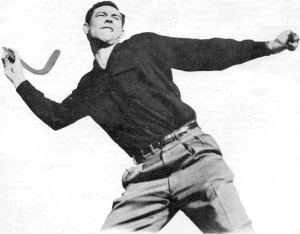 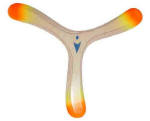
Here is a fascinating three-dimensional take-off on the old horse-shoe game. And with boomerangs
selling for a buck a throw, anybody can join in.
This is how we do it. A four-foot circle is marked off. We throw from the center of it into the wind.
The boomerang goes out, turns, swoops up, and comes gliding back downwind. If you are sharp it lands
with a calumph! near the circle. It is spinning madly all the while, and whirring like a duck's flight.
Naturally the man closest to the circle wins. However, you must make two successive wins to gain one
point. The person making a winning throw gets the lead. (Throws first.) Once you establish the lead
for a round (one throw each), every win you make counts a point. If you lose the lead it takes two wins
to get your next point. More than two can compete.
Now for the fancy business. It is easy to throw a boomerang, but learning to control this whiz-spinner
requires practice.
The "boomer" is held with the curved top surface of the wing always inside.
The plastic boomerangs will not fly properly as they come from the factory. You must add pitch, by
heating the center in hot water, or with a heat lamp. Never use an open flame. Twist about one-eighth
inch incidence into each wing, noting the leading edge of one is inside and the other out. More incidence
increases the lift, hastens the swoop upward, and shortens the orbit.
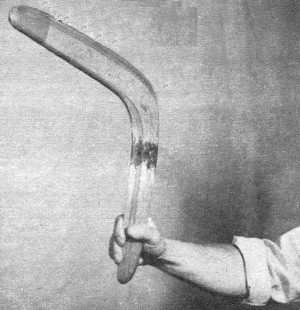
Cross section of the boomerang is an airfoil and in its flight it obeys the laws
of aerodynamics.
Now for the throw. Refer to the diagram: A. This is a "normal" throw calculated to land in the circle.
Release is at shoulder height. It applies in winds from 10 mph down to zero. Dead calm is the best weather
for beginners. Any wind causes the flight paths shown to move downwind, thus landing past the circle.
B. Here is a large orbit caused by low pitch. It requires a stronger throw. It does best in calm
air, and is a spectacular operation. The throw sends it far out, it circles way to the left (looks like
it will land in the next county), then comes in from behind. If the throw was hard enough it will come
whuffing past overhead, pause, and slide back for a landing at your feet.
C. Landing ahead of circle. An elevated throw occurs when you release earlier, and above shoulder
height. It causes a deep swoop on the downwind leg. Use this in windy weather. It requires a slightly
"flat" throw, a bit more into the wind.
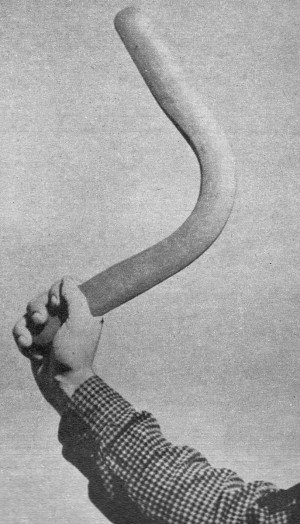
Correct launching position is important.
D. Landing downwind. The "flat" throw (wing parallel to the ground) is almost useless, and can result
in a broken boomerang. At the top of the high climb it falls back and loses rotational speed. A variation
of this, however, is useful.
Wind axis control. The opposite of a "flat" throw is of course the "vertical" (or normal) throw.
Actually a normal throw in calm weather is a bit flat, about five degrees off the vertical. As you approach
a true "vertical" launch the missile goes further into the wind and lands ahead of you, even though
completing an orbit. Finally too much "vertical" results in a dive into the ground far in front of you.
Side control. Never throw to the left of the wind. As much as a quarter off the wind (to the right)
is sometimes needed. You can adjust the lateral axis by launching more to the side you wish to land
on.
In windy weather try to keep the flight path close to the ground. Don't throw hard. We have flown
in 20 to 25 mph winds with reasonable accuracy, but it isn't easy.
The most important thing in technique is the spin. This is achieved by flicking your wrist as you
let go. Just like cracking a whip.
The grip you use will be determined by the size and strength of your fingers. Jim Lang has a large
hand so he grasps the boomer like a pencil. I hold it more like a club, with the little finger tucked
under for spin control.
Modelers take note: The boomerang does not stray so far from modeling as you might think. It is an
excellent way to work out a real hand-launch glider arm.
My partner in this sport, Jim Lang, is an aeronautical engineer. Therefore he did quite some investigating
on the scientific side. As he says, "You find some darned interesting aerodynamics in the boomerang.
Be surprised how it applies to model wing sections." And, "The boomerang retains its spinning throughout
the flight, and actually gains rotational speed, because it autorotates as it settles."
One manufacturer of high quality, laminated wood boomerangs is Col. John M. Gerrish, 4409 S.W. Parkview
Lane, Portland 1, Oregon.
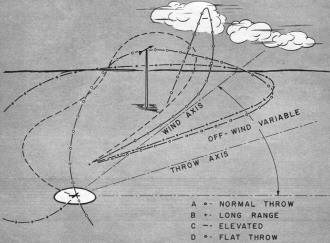
Boomerang Flight Paths
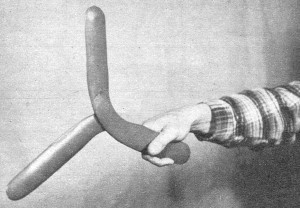
The "Lang" three-blader made from two broken plastic boomerangs. Throwing sequence
shown from right to left. This is release position.
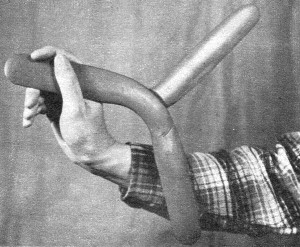
Initial launching stance. Emphasizes spin importer to all boomerang throws. Flight
of three-bladers differs from that of conventional ones.
Posted February 7, 2015
|


